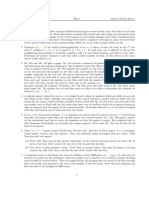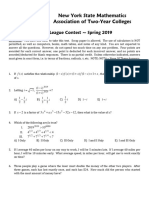1
ASSIGNMENT
1. We play the following game with an equilaterial triangle of n(n+1)/2 pennies (with n pennies on each
side). Initially, all of the pennies are turned heads up. On each turn, we may turn over three pennies
which are mutually adjacent; the goal is to make all of the pennies show tails. For which values of n
can this be achieved?
2. In Tumbolia there are n soccer teams. We want to organize a championship such that each team
plays exactly once with each other team. All games take place on Sundays, and a team can't play
more than one game in the same day. Determine the smallest positive integer m for which it is
possible to realize such a championship in m Sundays.
3. Albert and Barbara play the following game. On a table there are 1999 sticks: each player in turn
must remove from the table some sticks, provided that the player removes at least one stick and at
most half of the sticks remaining on the table. The player who leaves just one stick on the table loses
the game. Barbara moves first. Determine for which of the players there exists a winning strategy.
4. Two players play the following game. They in turn write on a blackboard different divisors of 100!
(except 1). A player loses if after his turn, the greatest common divisor of the all the numbers written
becomes 1. Which of the players has a winning strategy?
5. Given a fixed integer n > 1, Alberto and Barbara play the following game, starting with the first step
and then alternating between the second and third:
• Alberto chooses a positive integer.
• Barbara picks an integer greater than 1 which is a multiple or divisor of Alberto's number,
possibly choosing Alberto's number itself.
• Alberto adds or subtracts 1 from Barbara's number.
Barbara wins if she succeeds in picking n by her fiftieth move. For which values of n does she have a
winning strategy?
� 2
Answer
1. (--) 2. (--) 3. (--) 4. (--) 5. (--)
Solutions
1. We play the following game with an equilaterial triangle of n(n+1)/2 pennies (with n pennies on each
side). Initially, all of the pennies are turned heads up. On each turn, we may turn over three pennies
which are mutually adjacent; the goal is to make all of the pennies show tails. For which values of n
can this be achieved?
Sol.
2. In Tumbolia there are n soccer teams. We want to organize a championship such that each team
plays exactly once with each other team. All games take place on Sundays, and a team can't play
more than one game in the same day. Determine the smallest positive integer m for which it is
possible to realize such a championship in m Sundays.
� 3
Sol.
3. Albert and Barbara play the following game. On a table there are 1999 sticks: each player in turn
must remove from the table some sticks, provided that the player removes at least one stick and at
most half of the sticks remaining on the table. The player who leaves just one stick on the table loses
the game. Barbara moves first. Determine for which of the players there exists a winning strategy.
Sol.
4. Two players play the following game. They in turn write on a blackboard different divisors of 100!
(except 1). A player loses if after his turn, the greatest common divisor of the all the numbers written
becomes 1. Which of the players has a winning strategy?
Sol.
� 4
5. Given a fixed integer n > 1, Alberto and Barbara play the following game, starting with the first step
and then alternating between the second and third:
• Alberto chooses a positive integer.
• Barbara picks an integer greater than 1 which is a multiple or divisor of Alberto's number,
possibly choosing Alberto's number itself.
• Alberto adds or subtracts 1 from Barbara's number.
Barbara wins if she succeeds in picking n by her fiftieth move. For which values of n does she have a
winning strategy?
Sol.
�5




















































































